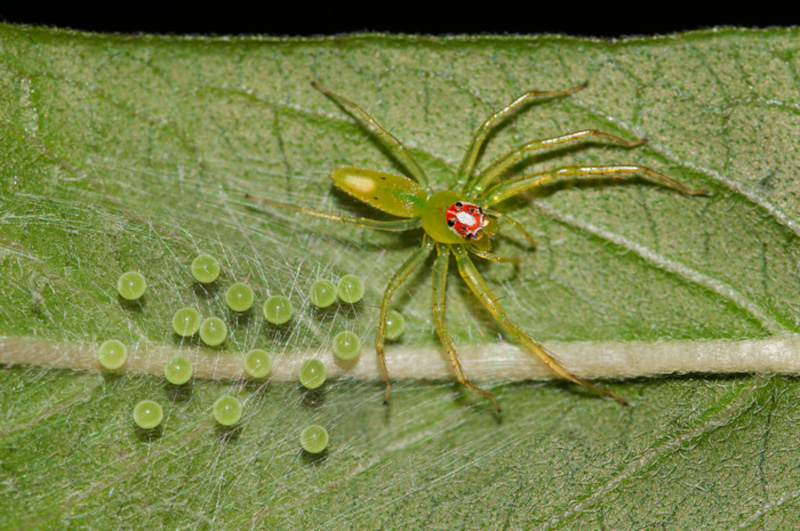Magnolia Green Jumper Facts
- The descriptive term of Magnolia Green Jumper presently serves as the most frequently used name for this gorgeous arachnid. It also happens to be the only generally accepted common name it has. Though certainly not unknown, that’s somewhat uncommon.
- Scientific professionals, meanwhile, more often refer to this invertebrate by its official moniker. This term, however, typically used by experts, such as researchers, is harder to pronounce. That’s because the spider bears the official name of he Lyssomanes viridis.
- The dazzling creation of Nature and evolution received this name due to the work of the respected French scientist, Charles, Athanase Walckenaer. He made the first formal acknowledgement of it as a separate and distinct species. This he accomplished in 1837.
- For the moment, this remarkable creature appears to be maintaining a population base that’s both sizeable and stable. That trend further seems to hold true throughout the entirety of its native range. The IUCN, therefore, currently has no listing for it.
- This distinctive arachnid should nevertheless be considered to be facing at least some threats to its continued existence. The majority of these, however, are the same as those perils currently facing the majority of the species on earth, if not all of them.
- Due to the nature of its habitat, the brilliant Magnolia Green Jumper faces the degradation or outright loss of much of its previous range. The greatest threat the Arthropod faces, though, most likely consists of the effects of ongoing climate change.
Related Articles
Magnolia Green Jumper Physical Description
The dazzling Magnolia Green Jumper quickly draws the interest of all those fortunate enough to encounter one. You might even say their distinctiveness jumps out at you! It’s worth noting, however, that the spider merits this interest for reasons other that sheer size.
That’s because this gorgeous creation of millions of years of evolution easily ranks as comparatively small for a variety of jumping spider. Like many of its kindred, the remarkable arachnid also displays a moderate degree of the physiological trait of sexual dimorphism.
In its case, this manifests itself in terms of size. Specifically, the females typically attain a slightly greater size than their male counterparts. Females average a body length measuring about 0.28 – 0.31 in (7 – 8 mm). Males, though, only average 0.20 – 0.24 in (5 – 6 mm).
It’s also noted for possessing somewhat longer legs than average, for a jumping spider, relative to body size. This arachnid further evolved highly complex eyes. These, in fact, provide it with some of the most highly developed and acute vision of all known arthropds.
Yet, it’s the coloring of the aptly-named Magnolia Green Jumper that receives most of the attention. Among mature specimens of both genders, this consists of a mainly pale, nearly translucent green. This, obviously, serves as the source of part of its name.
Other colors also appear, though usually in minute quantities. Several small black spots typically appear on the abdomen. Small scales on the fringes of the body also often manifest varying shades. These generally include such colors as orange, yellow, red, or white.
- Kingdom: Animalia
- Phylum: Arthropoda
- Class: Arachnida
- Order: Araneae
- Family: Salticidae
- Genus: Lyssomanes
- Species: L. viridis
Magnolia Green Jumper Distribution, Habitat, and Ecology
Fortuntely for it, the Magnolia Green Jumper seems to inhabit a comparatively broad section of the globe. That holds true due to the fact that it resides in an area that extends across much of the continent of North America. It also appears in Central America.
Within that broader range, however, it makes its home in only selected sections. The great majority of its numbers live in the southeastern section of the United States. Sporadic sightings of the small animal do occur as far south as the country of Guatemala, though.
The impressive species further exhibits decided preferences in its choice of habitat. Most sighted specimens live in regions of warm, humid forests. Part of its common name also derives from its strong preference for magnolia trees, especially the Southern Magnolia.
Yet, this wonder of Nature also makes appearances in other types of trees, including such types as pine, maple, and oak. Some individuals also live on bushes near the ground. Although it seems to prefer moister climates, specimens often appear in dryer climates, too.
Like virtually all of its relatives, the Magnolia Green Jumper evolved as carnivorous in nature. The only known exception to that pattern is the Bagheera kiplingi. This spider hunts as an ambush predator, typically lunging short distances to pounce on its hapless prey.
Mating occurs in Spring, mainly in May. Subsequent to that, females lay between 25 – 70 eggs. These she places on the underside of leaves. She also guards them closely until they hatch. Folowing their hatching, the female generally perishes soon after, usually by August.
Species Sharing Its Range
Check out our other articles on 7 Remarkably Riveting Asian Reptiles, Blood Shrimp, Villarrica, Snowshoe Hare, Texas Blind Salamander, Smooth Purple Coneflower, Blue-lipped sea krait

